Exploring Race and Ethnicity in Adolescents
VerifiedAdded on 2020/10/05
|10
|3043
|58
AI Summary
The provided report discusses six articles that investigate the concept of race and ethnicity in various contexts, including epidemiology, education, and social sciences. The articles highlight the importance of considering cultural, biological, and social factors when measuring REI. A multivariate analysis was conducted to determine if ethnic groups scored differently on five dimensions, with findings suggesting discerning the importance of one's REI includes two simultaneously tensions.
Contribute Materials
Your contribution can guide someone’s learning journey. Share your
documents today.
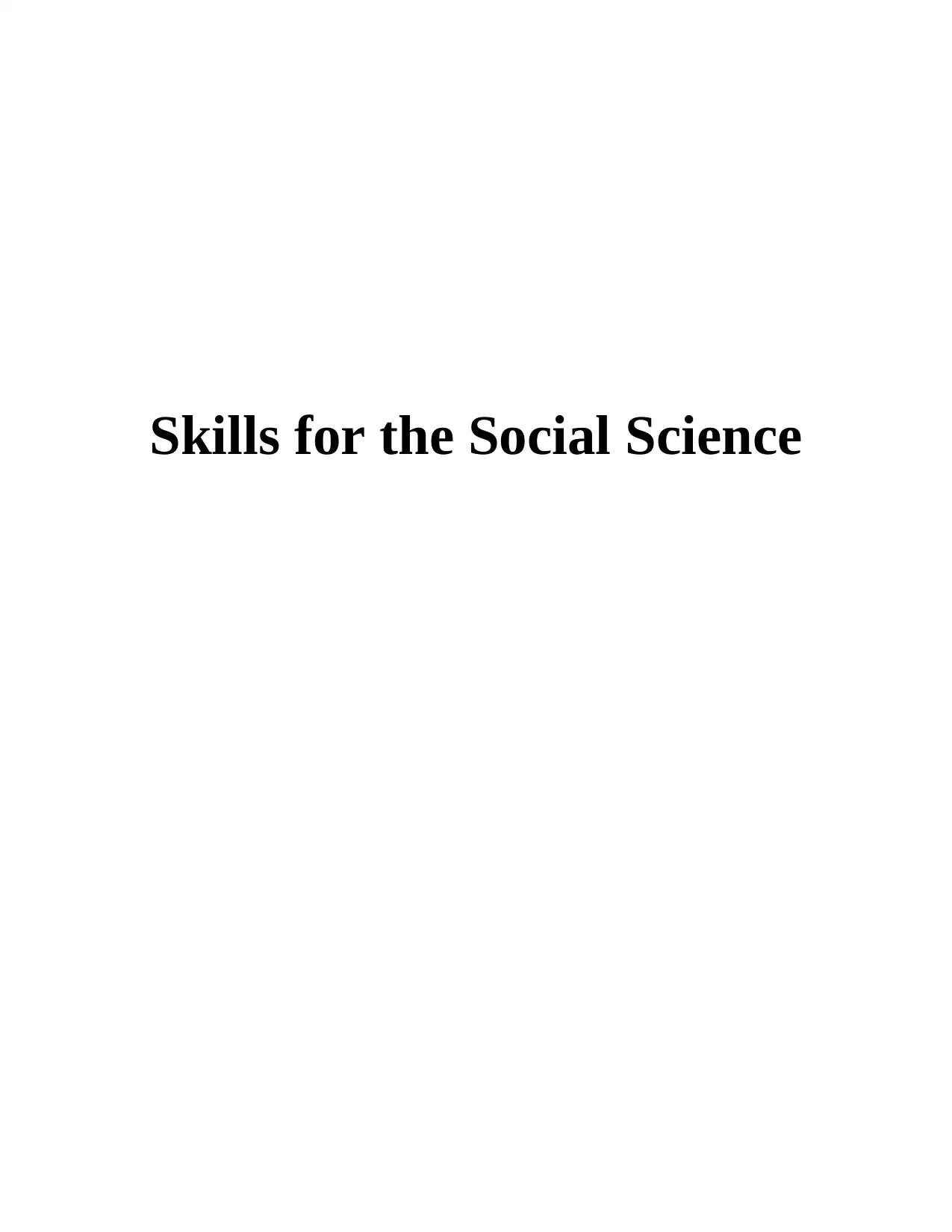
Skills for the Social Science
Secure Best Marks with AI Grader
Need help grading? Try our AI Grader for instant feedback on your assignments.
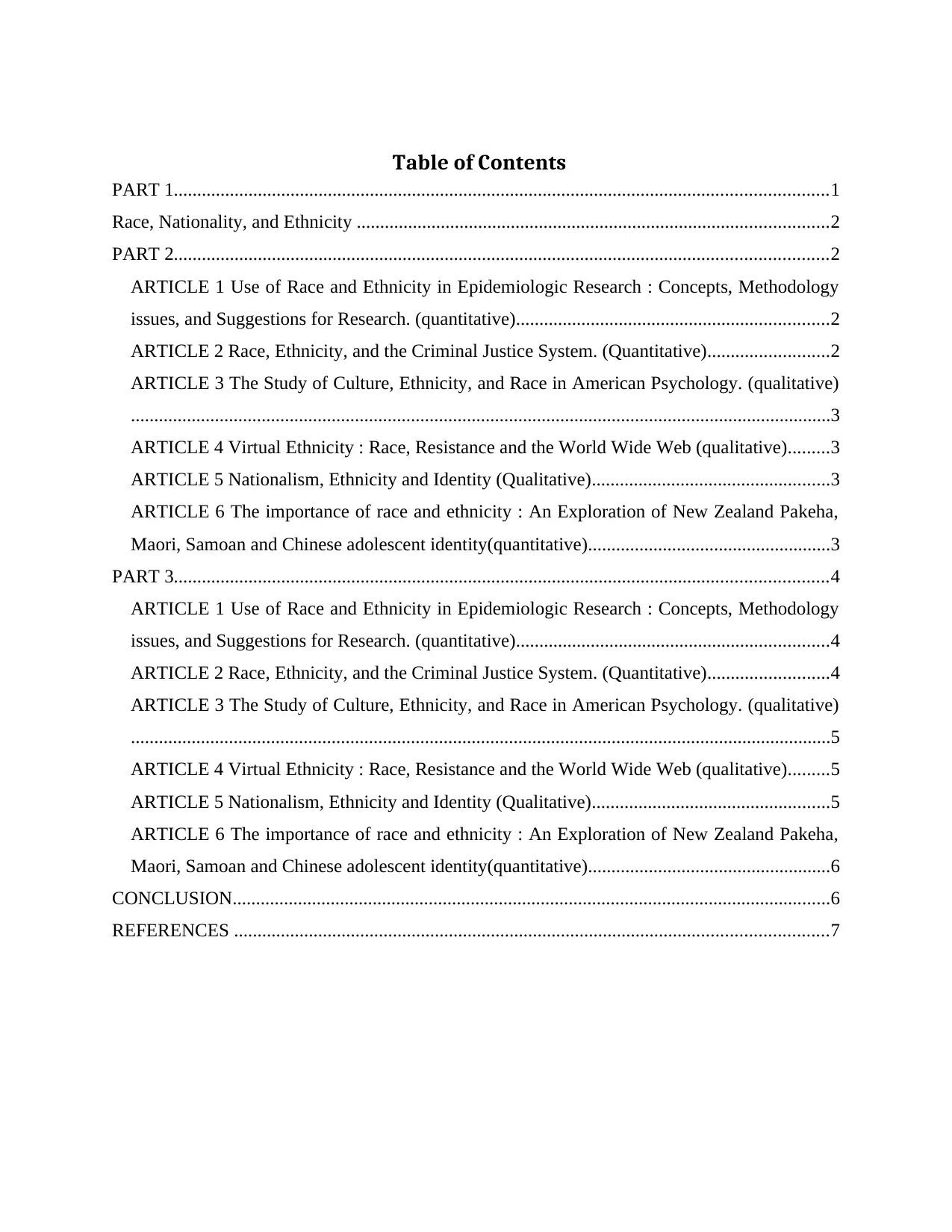
Table of Contents
PART 1............................................................................................................................................1
Race, Nationality, and Ethnicity .....................................................................................................2
PART 2............................................................................................................................................2
ARTICLE 1 Use of Race and Ethnicity in Epidemiologic Research : Concepts, Methodology
issues, and Suggestions for Research. (quantitative)...................................................................2
ARTICLE 2 Race, Ethnicity, and the Criminal Justice System. (Quantitative)..........................2
ARTICLE 3 The Study of Culture, Ethnicity, and Race in American Psychology. (qualitative)
......................................................................................................................................................3
ARTICLE 4 Virtual Ethnicity : Race, Resistance and the World Wide Web (qualitative).........3
ARTICLE 5 Nationalism, Ethnicity and Identity (Qualitative)...................................................3
ARTICLE 6 The importance of race and ethnicity : An Exploration of New Zealand Pakeha,
Maori, Samoan and Chinese adolescent identity(quantitative)....................................................3
PART 3............................................................................................................................................4
ARTICLE 1 Use of Race and Ethnicity in Epidemiologic Research : Concepts, Methodology
issues, and Suggestions for Research. (quantitative)...................................................................4
ARTICLE 2 Race, Ethnicity, and the Criminal Justice System. (Quantitative)..........................4
ARTICLE 3 The Study of Culture, Ethnicity, and Race in American Psychology. (qualitative)
......................................................................................................................................................5
ARTICLE 4 Virtual Ethnicity : Race, Resistance and the World Wide Web (qualitative).........5
ARTICLE 5 Nationalism, Ethnicity and Identity (Qualitative)...................................................5
ARTICLE 6 The importance of race and ethnicity : An Exploration of New Zealand Pakeha,
Maori, Samoan and Chinese adolescent identity(quantitative)....................................................6
CONCLUSION................................................................................................................................6
REFERENCES ...............................................................................................................................7
PART 1............................................................................................................................................1
Race, Nationality, and Ethnicity .....................................................................................................2
PART 2............................................................................................................................................2
ARTICLE 1 Use of Race and Ethnicity in Epidemiologic Research : Concepts, Methodology
issues, and Suggestions for Research. (quantitative)...................................................................2
ARTICLE 2 Race, Ethnicity, and the Criminal Justice System. (Quantitative)..........................2
ARTICLE 3 The Study of Culture, Ethnicity, and Race in American Psychology. (qualitative)
......................................................................................................................................................3
ARTICLE 4 Virtual Ethnicity : Race, Resistance and the World Wide Web (qualitative).........3
ARTICLE 5 Nationalism, Ethnicity and Identity (Qualitative)...................................................3
ARTICLE 6 The importance of race and ethnicity : An Exploration of New Zealand Pakeha,
Maori, Samoan and Chinese adolescent identity(quantitative)....................................................3
PART 3............................................................................................................................................4
ARTICLE 1 Use of Race and Ethnicity in Epidemiologic Research : Concepts, Methodology
issues, and Suggestions for Research. (quantitative)...................................................................4
ARTICLE 2 Race, Ethnicity, and the Criminal Justice System. (Quantitative)..........................4
ARTICLE 3 The Study of Culture, Ethnicity, and Race in American Psychology. (qualitative)
......................................................................................................................................................5
ARTICLE 4 Virtual Ethnicity : Race, Resistance and the World Wide Web (qualitative).........5
ARTICLE 5 Nationalism, Ethnicity and Identity (Qualitative)...................................................5
ARTICLE 6 The importance of race and ethnicity : An Exploration of New Zealand Pakeha,
Maori, Samoan and Chinese adolescent identity(quantitative)....................................................6
CONCLUSION................................................................................................................................6
REFERENCES ...............................................................................................................................7

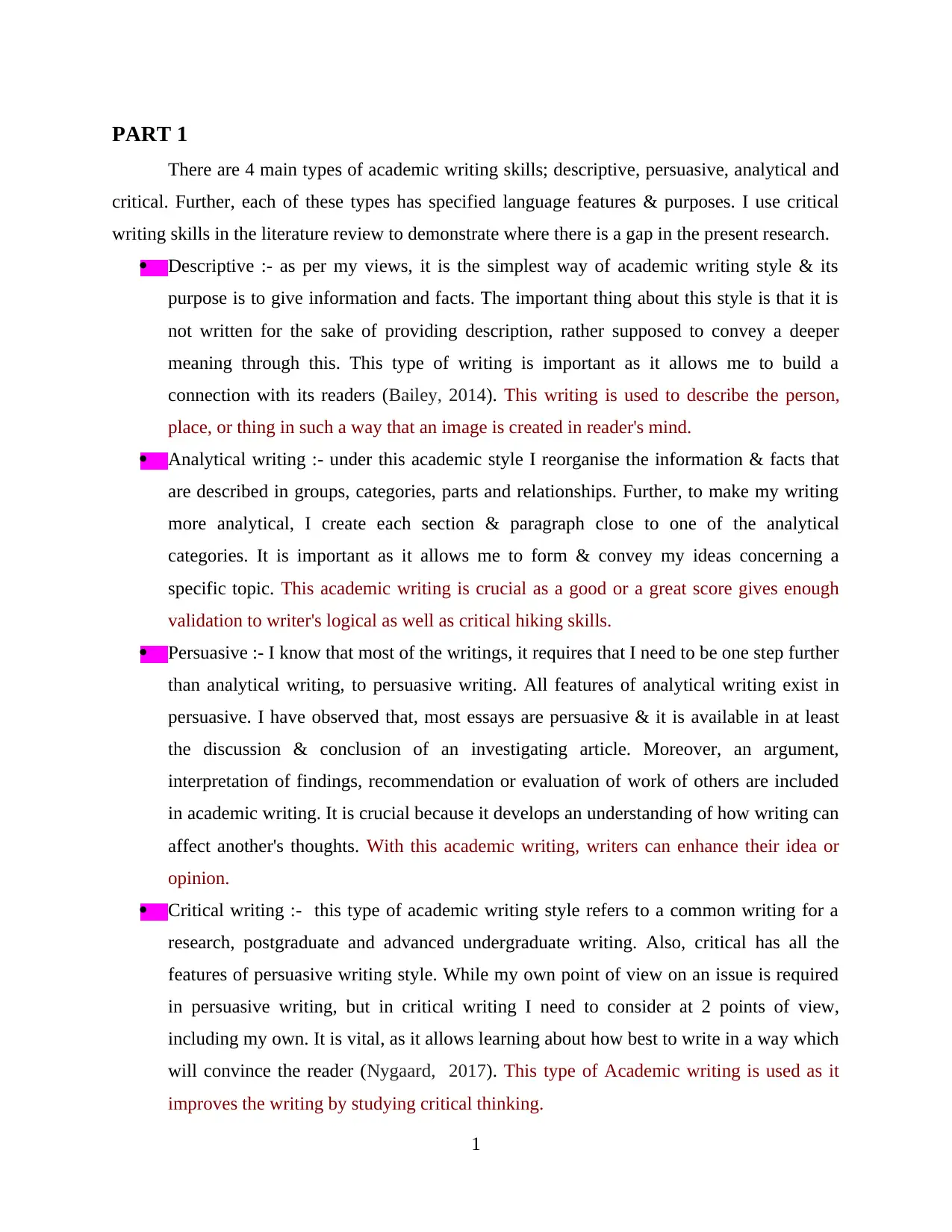
PART 1
There are 4 main types of academic writing skills; descriptive, persuasive, analytical and
critical. Further, each of these types has specified language features & purposes. I use critical
writing skills in the literature review to demonstrate where there is a gap in the present research.
Descriptive :- as per my views, it is the simplest way of academic writing style & its
purpose is to give information and facts. The important thing about this style is that it is
not written for the sake of providing description, rather supposed to convey a deeper
meaning through this. This type of writing is important as it allows me to build a
connection with its readers (Bailey, 2014). This writing is used to describe the person,
place, or thing in such a way that an image is created in reader's mind.
Analytical writing :- under this academic style I reorganise the information & facts that
are described in groups, categories, parts and relationships. Further, to make my writing
more analytical, I create each section & paragraph close to one of the analytical
categories. It is important as it allows me to form & convey my ideas concerning a
specific topic. This academic writing is crucial as a good or a great score gives enough
validation to writer's logical as well as critical hiking skills.
Persuasive :- I know that most of the writings, it requires that I need to be one step further
than analytical writing, to persuasive writing. All features of analytical writing exist in
persuasive. I have observed that, most essays are persuasive & it is available in at least
the discussion & conclusion of an investigating article. Moreover, an argument,
interpretation of findings, recommendation or evaluation of work of others are included
in academic writing. It is crucial because it develops an understanding of how writing can
affect another's thoughts. With this academic writing, writers can enhance their idea or
opinion.
Critical writing :- this type of academic writing style refers to a common writing for a
research, postgraduate and advanced undergraduate writing. Also, critical has all the
features of persuasive writing style. While my own point of view on an issue is required
in persuasive writing, but in critical writing I need to consider at 2 points of view,
including my own. It is vital, as it allows learning about how best to write in a way which
will convince the reader (Nygaard, 2017). This type of Academic writing is used as it
improves the writing by studying critical thinking.
1
There are 4 main types of academic writing skills; descriptive, persuasive, analytical and
critical. Further, each of these types has specified language features & purposes. I use critical
writing skills in the literature review to demonstrate where there is a gap in the present research.
Descriptive :- as per my views, it is the simplest way of academic writing style & its
purpose is to give information and facts. The important thing about this style is that it is
not written for the sake of providing description, rather supposed to convey a deeper
meaning through this. This type of writing is important as it allows me to build a
connection with its readers (Bailey, 2014). This writing is used to describe the person,
place, or thing in such a way that an image is created in reader's mind.
Analytical writing :- under this academic style I reorganise the information & facts that
are described in groups, categories, parts and relationships. Further, to make my writing
more analytical, I create each section & paragraph close to one of the analytical
categories. It is important as it allows me to form & convey my ideas concerning a
specific topic. This academic writing is crucial as a good or a great score gives enough
validation to writer's logical as well as critical hiking skills.
Persuasive :- I know that most of the writings, it requires that I need to be one step further
than analytical writing, to persuasive writing. All features of analytical writing exist in
persuasive. I have observed that, most essays are persuasive & it is available in at least
the discussion & conclusion of an investigating article. Moreover, an argument,
interpretation of findings, recommendation or evaluation of work of others are included
in academic writing. It is crucial because it develops an understanding of how writing can
affect another's thoughts. With this academic writing, writers can enhance their idea or
opinion.
Critical writing :- this type of academic writing style refers to a common writing for a
research, postgraduate and advanced undergraduate writing. Also, critical has all the
features of persuasive writing style. While my own point of view on an issue is required
in persuasive writing, but in critical writing I need to consider at 2 points of view,
including my own. It is vital, as it allows learning about how best to write in a way which
will convince the reader (Nygaard, 2017). This type of Academic writing is used as it
improves the writing by studying critical thinking.
1
Secure Best Marks with AI Grader
Need help grading? Try our AI Grader for instant feedback on your assignments.

Race, Nationality, and Ethnicity
It has been observed that, most controversial among these three i.e. race, nationality and
ethnicity is Race. In today's world, physical differences among human beings are obvious, as
race refers to a group of people who have similar & well-defined physical features such as; hair,
or skin colour. On the other, nationality refers to a person that has born in other country or state
to which a person belongs and has legal rights of a citizen. Therefore, it is determined as the
legal connection between a person & a sovereign state. Furthermore, ethnic group or ethnicity is
a group of people who regard themselves to be distinguished from other groups based on culture,
social, national and ancestral experience. Therefore, the concept of these three have, and
continue to be the topic of much debate.
PART 2
ARTICLE 1 Use of Race and Ethnicity in Epidemiologic Research : Concepts, Methodology
issues, and Suggestions for Research. (quantitative)
The article is based on population of US who has experienced excellent growth. In last
century, with must of growth was contributed by minority population. Such as; age, gender, or
ethnicity are present variables utilised throughout the investigation of epidemiologic including
the broader context of public health. Moreover, it has been observed that, investigators working
within racially & ethnically variant study populations and also may require considering other
problems that may influence how a person answers a particular question through a survey.
ARTICLE 2 Race, Ethnicity, and the Criminal Justice System. (Quantitative)
This research paper highlights data & research findings on ethnic and racial imbalance in
criminal justice system in the United States. In addition, mixed approach analytical technique
that make use of both rigorous qualitative and quantitative techniques are essential for better
knowing the aspects of criminal justice processing starting with arrest in specifically for
juveniles.
ARTICLE 3 The Study of Culture, Ethnicity, and Race in American Psychology. (qualitative)
The purpose of this article is to share about preoccupations & thoughts concerning the
status of the research of culture & associated conceptual framework of race, and ethnicity in
2
It has been observed that, most controversial among these three i.e. race, nationality and
ethnicity is Race. In today's world, physical differences among human beings are obvious, as
race refers to a group of people who have similar & well-defined physical features such as; hair,
or skin colour. On the other, nationality refers to a person that has born in other country or state
to which a person belongs and has legal rights of a citizen. Therefore, it is determined as the
legal connection between a person & a sovereign state. Furthermore, ethnic group or ethnicity is
a group of people who regard themselves to be distinguished from other groups based on culture,
social, national and ancestral experience. Therefore, the concept of these three have, and
continue to be the topic of much debate.
PART 2
ARTICLE 1 Use of Race and Ethnicity in Epidemiologic Research : Concepts, Methodology
issues, and Suggestions for Research. (quantitative)
The article is based on population of US who has experienced excellent growth. In last
century, with must of growth was contributed by minority population. Such as; age, gender, or
ethnicity are present variables utilised throughout the investigation of epidemiologic including
the broader context of public health. Moreover, it has been observed that, investigators working
within racially & ethnically variant study populations and also may require considering other
problems that may influence how a person answers a particular question through a survey.
ARTICLE 2 Race, Ethnicity, and the Criminal Justice System. (Quantitative)
This research paper highlights data & research findings on ethnic and racial imbalance in
criminal justice system in the United States. In addition, mixed approach analytical technique
that make use of both rigorous qualitative and quantitative techniques are essential for better
knowing the aspects of criminal justice processing starting with arrest in specifically for
juveniles.
ARTICLE 3 The Study of Culture, Ethnicity, and Race in American Psychology. (qualitative)
The purpose of this article is to share about preoccupations & thoughts concerning the
status of the research of culture & associated conceptual framework of race, and ethnicity in
2
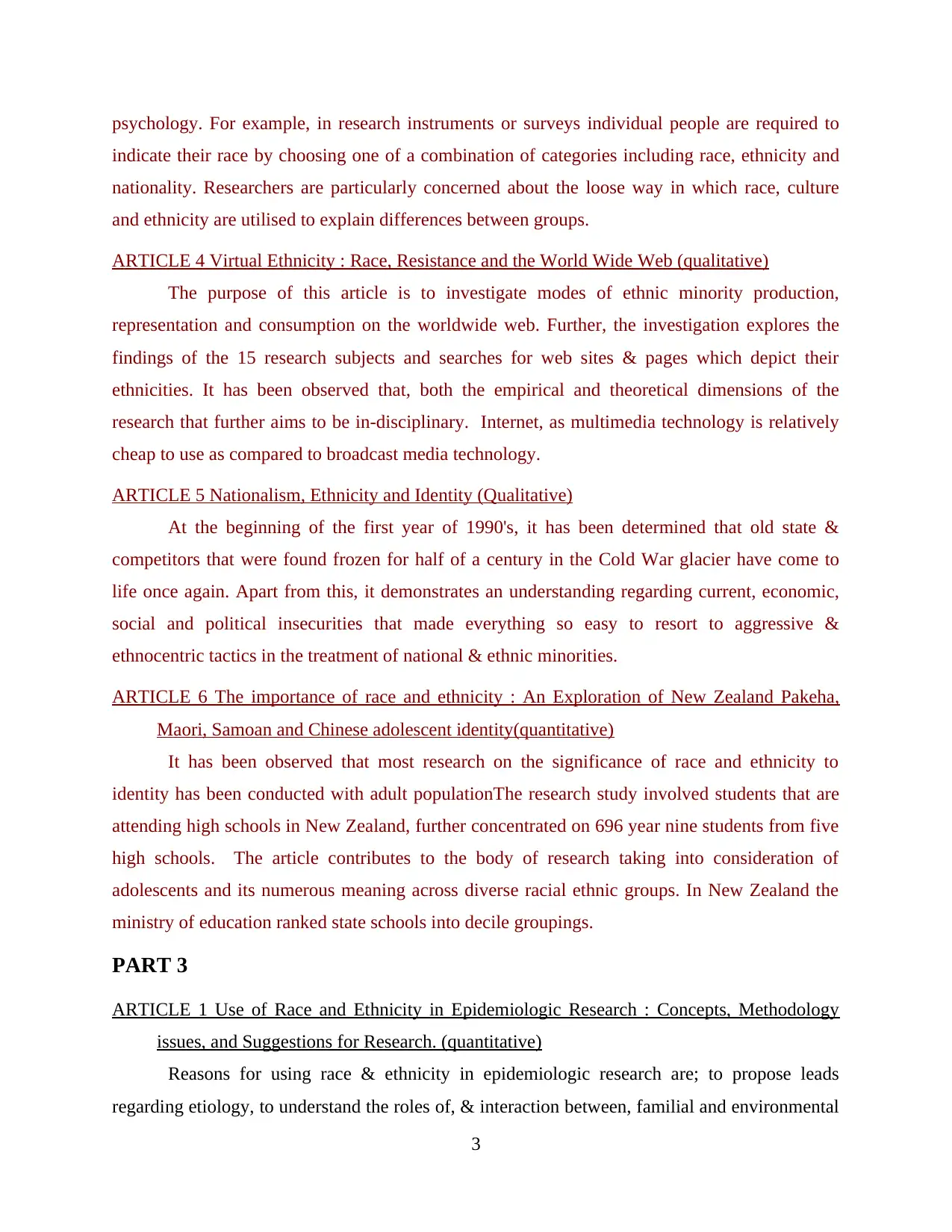
psychology. For example, in research instruments or surveys individual people are required to
indicate their race by choosing one of a combination of categories including race, ethnicity and
nationality. Researchers are particularly concerned about the loose way in which race, culture
and ethnicity are utilised to explain differences between groups.
ARTICLE 4 Virtual Ethnicity : Race, Resistance and the World Wide Web (qualitative)
The purpose of this article is to investigate modes of ethnic minority production,
representation and consumption on the worldwide web. Further, the investigation explores the
findings of the 15 research subjects and searches for web sites & pages which depict their
ethnicities. It has been observed that, both the empirical and theoretical dimensions of the
research that further aims to be in-disciplinary. Internet, as multimedia technology is relatively
cheap to use as compared to broadcast media technology.
ARTICLE 5 Nationalism, Ethnicity and Identity (Qualitative)
At the beginning of the first year of 1990's, it has been determined that old state &
competitors that were found frozen for half of a century in the Cold War glacier have come to
life once again. Apart from this, it demonstrates an understanding regarding current, economic,
social and political insecurities that made everything so easy to resort to aggressive &
ethnocentric tactics in the treatment of national & ethnic minorities.
ARTICLE 6 The importance of race and ethnicity : An Exploration of New Zealand Pakeha,
Maori, Samoan and Chinese adolescent identity(quantitative)
It has been observed that most research on the significance of race and ethnicity to
identity has been conducted with adult populationThe research study involved students that are
attending high schools in New Zealand, further concentrated on 696 year nine students from five
high schools. The article contributes to the body of research taking into consideration of
adolescents and its numerous meaning across diverse racial ethnic groups. In New Zealand the
ministry of education ranked state schools into decile groupings.
PART 3
ARTICLE 1 Use of Race and Ethnicity in Epidemiologic Research : Concepts, Methodology
issues, and Suggestions for Research. (quantitative)
Reasons for using race & ethnicity in epidemiologic research are; to propose leads
regarding etiology, to understand the roles of, & interaction between, familial and environmental
3
indicate their race by choosing one of a combination of categories including race, ethnicity and
nationality. Researchers are particularly concerned about the loose way in which race, culture
and ethnicity are utilised to explain differences between groups.
ARTICLE 4 Virtual Ethnicity : Race, Resistance and the World Wide Web (qualitative)
The purpose of this article is to investigate modes of ethnic minority production,
representation and consumption on the worldwide web. Further, the investigation explores the
findings of the 15 research subjects and searches for web sites & pages which depict their
ethnicities. It has been observed that, both the empirical and theoretical dimensions of the
research that further aims to be in-disciplinary. Internet, as multimedia technology is relatively
cheap to use as compared to broadcast media technology.
ARTICLE 5 Nationalism, Ethnicity and Identity (Qualitative)
At the beginning of the first year of 1990's, it has been determined that old state &
competitors that were found frozen for half of a century in the Cold War glacier have come to
life once again. Apart from this, it demonstrates an understanding regarding current, economic,
social and political insecurities that made everything so easy to resort to aggressive &
ethnocentric tactics in the treatment of national & ethnic minorities.
ARTICLE 6 The importance of race and ethnicity : An Exploration of New Zealand Pakeha,
Maori, Samoan and Chinese adolescent identity(quantitative)
It has been observed that most research on the significance of race and ethnicity to
identity has been conducted with adult populationThe research study involved students that are
attending high schools in New Zealand, further concentrated on 696 year nine students from five
high schools. The article contributes to the body of research taking into consideration of
adolescents and its numerous meaning across diverse racial ethnic groups. In New Zealand the
ministry of education ranked state schools into decile groupings.
PART 3
ARTICLE 1 Use of Race and Ethnicity in Epidemiologic Research : Concepts, Methodology
issues, and Suggestions for Research. (quantitative)
Reasons for using race & ethnicity in epidemiologic research are; to propose leads
regarding etiology, to understand the roles of, & interaction between, familial and environmental
3
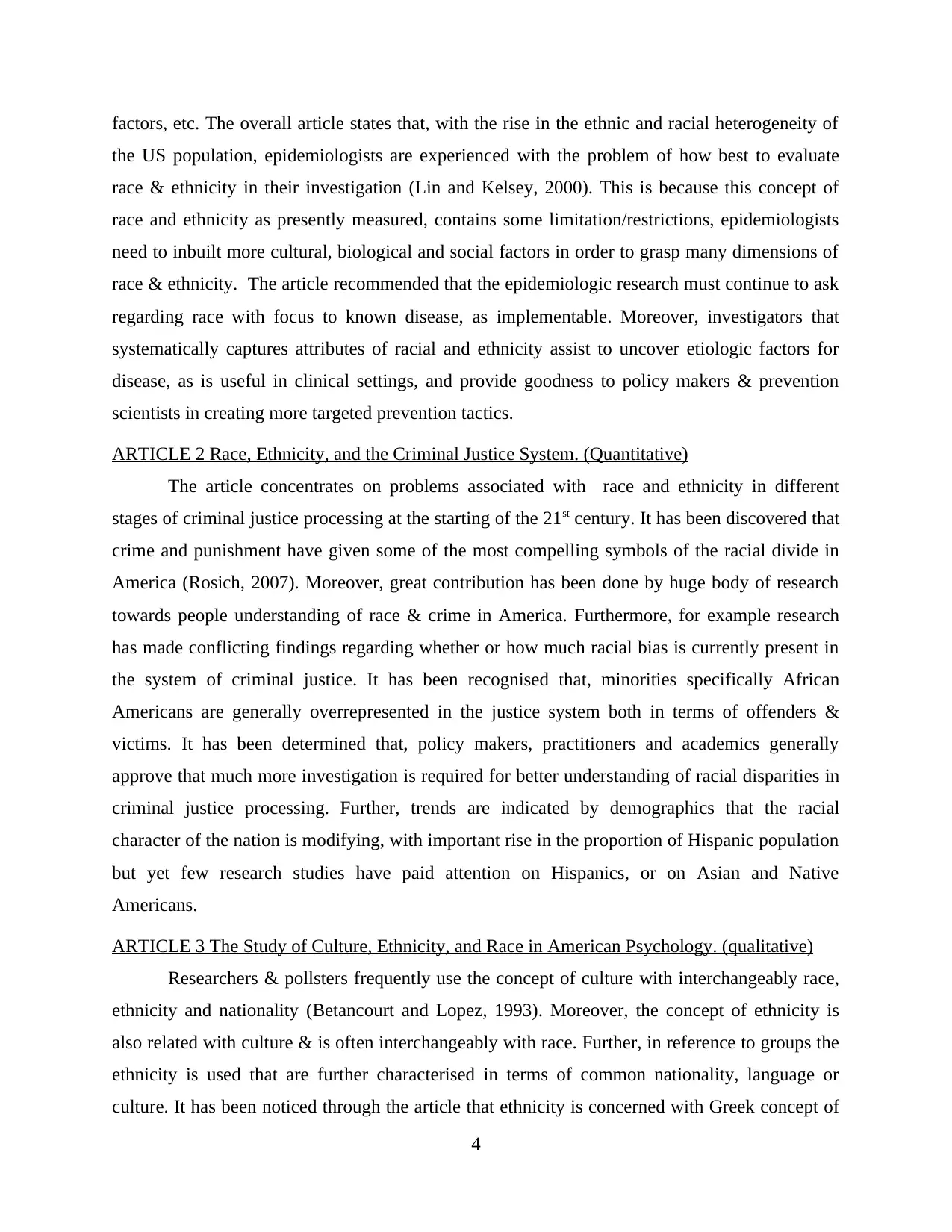
factors, etc. The overall article states that, with the rise in the ethnic and racial heterogeneity of
the US population, epidemiologists are experienced with the problem of how best to evaluate
race & ethnicity in their investigation (Lin and Kelsey, 2000). This is because this concept of
race and ethnicity as presently measured, contains some limitation/restrictions, epidemiologists
need to inbuilt more cultural, biological and social factors in order to grasp many dimensions of
race & ethnicity. The article recommended that the epidemiologic research must continue to ask
regarding race with focus to known disease, as implementable. Moreover, investigators that
systematically captures attributes of racial and ethnicity assist to uncover etiologic factors for
disease, as is useful in clinical settings, and provide goodness to policy makers & prevention
scientists in creating more targeted prevention tactics.
ARTICLE 2 Race, Ethnicity, and the Criminal Justice System. (Quantitative)
The article concentrates on problems associated with race and ethnicity in different
stages of criminal justice processing at the starting of the 21st century. It has been discovered that
crime and punishment have given some of the most compelling symbols of the racial divide in
America (Rosich, 2007). Moreover, great contribution has been done by huge body of research
towards people understanding of race & crime in America. Furthermore, for example research
has made conflicting findings regarding whether or how much racial bias is currently present in
the system of criminal justice. It has been recognised that, minorities specifically African
Americans are generally overrepresented in the justice system both in terms of offenders &
victims. It has been determined that, policy makers, practitioners and academics generally
approve that much more investigation is required for better understanding of racial disparities in
criminal justice processing. Further, trends are indicated by demographics that the racial
character of the nation is modifying, with important rise in the proportion of Hispanic population
but yet few research studies have paid attention on Hispanics, or on Asian and Native
Americans.
ARTICLE 3 The Study of Culture, Ethnicity, and Race in American Psychology. (qualitative)
Researchers & pollsters frequently use the concept of culture with interchangeably race,
ethnicity and nationality (Betancourt and Lopez, 1993). Moreover, the concept of ethnicity is
also related with culture & is often interchangeably with race. Further, in reference to groups the
ethnicity is used that are further characterised in terms of common nationality, language or
culture. It has been noticed through the article that ethnicity is concerned with Greek concept of
4
the US population, epidemiologists are experienced with the problem of how best to evaluate
race & ethnicity in their investigation (Lin and Kelsey, 2000). This is because this concept of
race and ethnicity as presently measured, contains some limitation/restrictions, epidemiologists
need to inbuilt more cultural, biological and social factors in order to grasp many dimensions of
race & ethnicity. The article recommended that the epidemiologic research must continue to ask
regarding race with focus to known disease, as implementable. Moreover, investigators that
systematically captures attributes of racial and ethnicity assist to uncover etiologic factors for
disease, as is useful in clinical settings, and provide goodness to policy makers & prevention
scientists in creating more targeted prevention tactics.
ARTICLE 2 Race, Ethnicity, and the Criminal Justice System. (Quantitative)
The article concentrates on problems associated with race and ethnicity in different
stages of criminal justice processing at the starting of the 21st century. It has been discovered that
crime and punishment have given some of the most compelling symbols of the racial divide in
America (Rosich, 2007). Moreover, great contribution has been done by huge body of research
towards people understanding of race & crime in America. Furthermore, for example research
has made conflicting findings regarding whether or how much racial bias is currently present in
the system of criminal justice. It has been recognised that, minorities specifically African
Americans are generally overrepresented in the justice system both in terms of offenders &
victims. It has been determined that, policy makers, practitioners and academics generally
approve that much more investigation is required for better understanding of racial disparities in
criminal justice processing. Further, trends are indicated by demographics that the racial
character of the nation is modifying, with important rise in the proportion of Hispanic population
but yet few research studies have paid attention on Hispanics, or on Asian and Native
Americans.
ARTICLE 3 The Study of Culture, Ethnicity, and Race in American Psychology. (qualitative)
Researchers & pollsters frequently use the concept of culture with interchangeably race,
ethnicity and nationality (Betancourt and Lopez, 1993). Moreover, the concept of ethnicity is
also related with culture & is often interchangeably with race. Further, in reference to groups the
ethnicity is used that are further characterised in terms of common nationality, language or
culture. It has been noticed through the article that ethnicity is concerned with Greek concept of
4
Paraphrase This Document
Need a fresh take? Get an instant paraphrase of this document with our AI Paraphraser
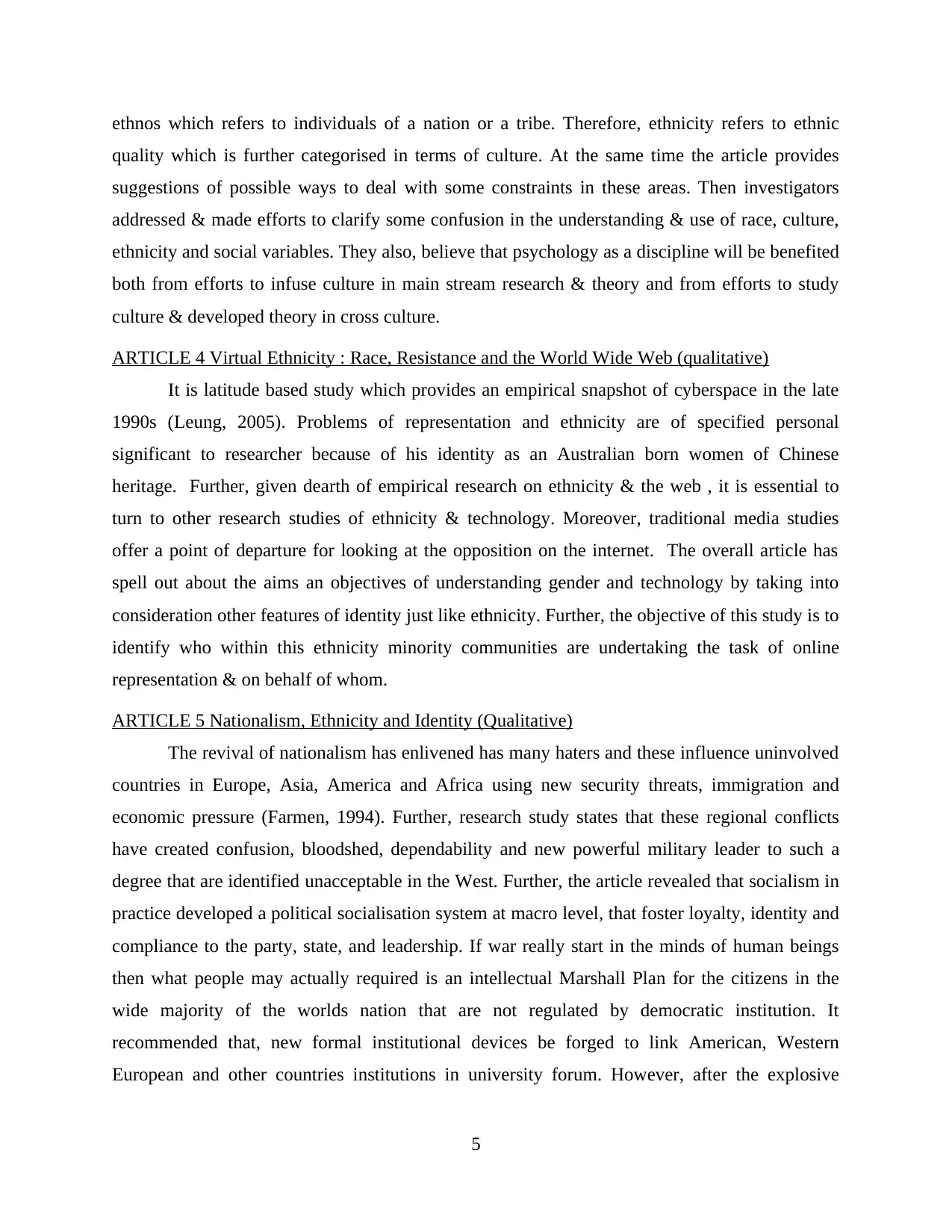
ethnos which refers to individuals of a nation or a tribe. Therefore, ethnicity refers to ethnic
quality which is further categorised in terms of culture. At the same time the article provides
suggestions of possible ways to deal with some constraints in these areas. Then investigators
addressed & made efforts to clarify some confusion in the understanding & use of race, culture,
ethnicity and social variables. They also, believe that psychology as a discipline will be benefited
both from efforts to infuse culture in main stream research & theory and from efforts to study
culture & developed theory in cross culture.
ARTICLE 4 Virtual Ethnicity : Race, Resistance and the World Wide Web (qualitative)
It is latitude based study which provides an empirical snapshot of cyberspace in the late
1990s (Leung, 2005). Problems of representation and ethnicity are of specified personal
significant to researcher because of his identity as an Australian born women of Chinese
heritage. Further, given dearth of empirical research on ethnicity & the web , it is essential to
turn to other research studies of ethnicity & technology. Moreover, traditional media studies
offer a point of departure for looking at the opposition on the internet. The overall article has
spell out about the aims an objectives of understanding gender and technology by taking into
consideration other features of identity just like ethnicity. Further, the objective of this study is to
identify who within this ethnicity minority communities are undertaking the task of online
representation & on behalf of whom.
ARTICLE 5 Nationalism, Ethnicity and Identity (Qualitative)
The revival of nationalism has enlivened has many haters and these influence uninvolved
countries in Europe, Asia, America and Africa using new security threats, immigration and
economic pressure (Farmen, 1994). Further, research study states that these regional conflicts
have created confusion, bloodshed, dependability and new powerful military leader to such a
degree that are identified unacceptable in the West. Further, the article revealed that socialism in
practice developed a political socialisation system at macro level, that foster loyalty, identity and
compliance to the party, state, and leadership. If war really start in the minds of human beings
then what people may actually required is an intellectual Marshall Plan for the citizens in the
wide majority of the worlds nation that are not regulated by democratic institution. It
recommended that, new formal institutional devices be forged to link American, Western
European and other countries institutions in university forum. However, after the explosive
5
quality which is further categorised in terms of culture. At the same time the article provides
suggestions of possible ways to deal with some constraints in these areas. Then investigators
addressed & made efforts to clarify some confusion in the understanding & use of race, culture,
ethnicity and social variables. They also, believe that psychology as a discipline will be benefited
both from efforts to infuse culture in main stream research & theory and from efforts to study
culture & developed theory in cross culture.
ARTICLE 4 Virtual Ethnicity : Race, Resistance and the World Wide Web (qualitative)
It is latitude based study which provides an empirical snapshot of cyberspace in the late
1990s (Leung, 2005). Problems of representation and ethnicity are of specified personal
significant to researcher because of his identity as an Australian born women of Chinese
heritage. Further, given dearth of empirical research on ethnicity & the web , it is essential to
turn to other research studies of ethnicity & technology. Moreover, traditional media studies
offer a point of departure for looking at the opposition on the internet. The overall article has
spell out about the aims an objectives of understanding gender and technology by taking into
consideration other features of identity just like ethnicity. Further, the objective of this study is to
identify who within this ethnicity minority communities are undertaking the task of online
representation & on behalf of whom.
ARTICLE 5 Nationalism, Ethnicity and Identity (Qualitative)
The revival of nationalism has enlivened has many haters and these influence uninvolved
countries in Europe, Asia, America and Africa using new security threats, immigration and
economic pressure (Farmen, 1994). Further, research study states that these regional conflicts
have created confusion, bloodshed, dependability and new powerful military leader to such a
degree that are identified unacceptable in the West. Further, the article revealed that socialism in
practice developed a political socialisation system at macro level, that foster loyalty, identity and
compliance to the party, state, and leadership. If war really start in the minds of human beings
then what people may actually required is an intellectual Marshall Plan for the citizens in the
wide majority of the worlds nation that are not regulated by democratic institution. It
recommended that, new formal institutional devices be forged to link American, Western
European and other countries institutions in university forum. However, after the explosive
5
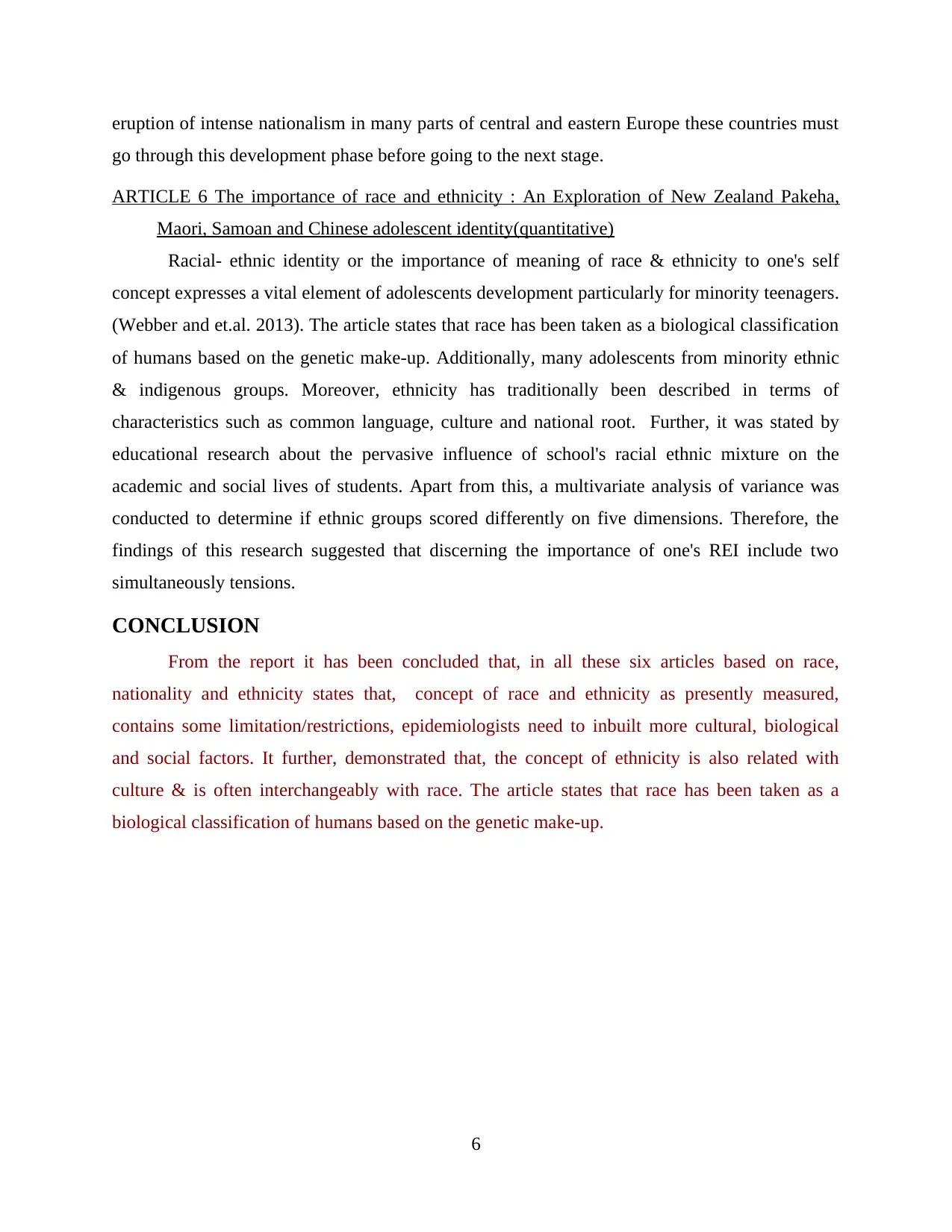
eruption of intense nationalism in many parts of central and eastern Europe these countries must
go through this development phase before going to the next stage.
ARTICLE 6 The importance of race and ethnicity : An Exploration of New Zealand Pakeha,
Maori, Samoan and Chinese adolescent identity(quantitative)
Racial- ethnic identity or the importance of meaning of race & ethnicity to one's self
concept expresses a vital element of adolescents development particularly for minority teenagers.
(Webber and et.al. 2013). The article states that race has been taken as a biological classification
of humans based on the genetic make-up. Additionally, many adolescents from minority ethnic
& indigenous groups. Moreover, ethnicity has traditionally been described in terms of
characteristics such as common language, culture and national root. Further, it was stated by
educational research about the pervasive influence of school's racial ethnic mixture on the
academic and social lives of students. Apart from this, a multivariate analysis of variance was
conducted to determine if ethnic groups scored differently on five dimensions. Therefore, the
findings of this research suggested that discerning the importance of one's REI include two
simultaneously tensions.
CONCLUSION
From the report it has been concluded that, in all these six articles based on race,
nationality and ethnicity states that, concept of race and ethnicity as presently measured,
contains some limitation/restrictions, epidemiologists need to inbuilt more cultural, biological
and social factors. It further, demonstrated that, the concept of ethnicity is also related with
culture & is often interchangeably with race. The article states that race has been taken as a
biological classification of humans based on the genetic make-up.
6
go through this development phase before going to the next stage.
ARTICLE 6 The importance of race and ethnicity : An Exploration of New Zealand Pakeha,
Maori, Samoan and Chinese adolescent identity(quantitative)
Racial- ethnic identity or the importance of meaning of race & ethnicity to one's self
concept expresses a vital element of adolescents development particularly for minority teenagers.
(Webber and et.al. 2013). The article states that race has been taken as a biological classification
of humans based on the genetic make-up. Additionally, many adolescents from minority ethnic
& indigenous groups. Moreover, ethnicity has traditionally been described in terms of
characteristics such as common language, culture and national root. Further, it was stated by
educational research about the pervasive influence of school's racial ethnic mixture on the
academic and social lives of students. Apart from this, a multivariate analysis of variance was
conducted to determine if ethnic groups scored differently on five dimensions. Therefore, the
findings of this research suggested that discerning the importance of one's REI include two
simultaneously tensions.
CONCLUSION
From the report it has been concluded that, in all these six articles based on race,
nationality and ethnicity states that, concept of race and ethnicity as presently measured,
contains some limitation/restrictions, epidemiologists need to inbuilt more cultural, biological
and social factors. It further, demonstrated that, the concept of ethnicity is also related with
culture & is often interchangeably with race. The article states that race has been taken as a
biological classification of humans based on the genetic make-up.
6
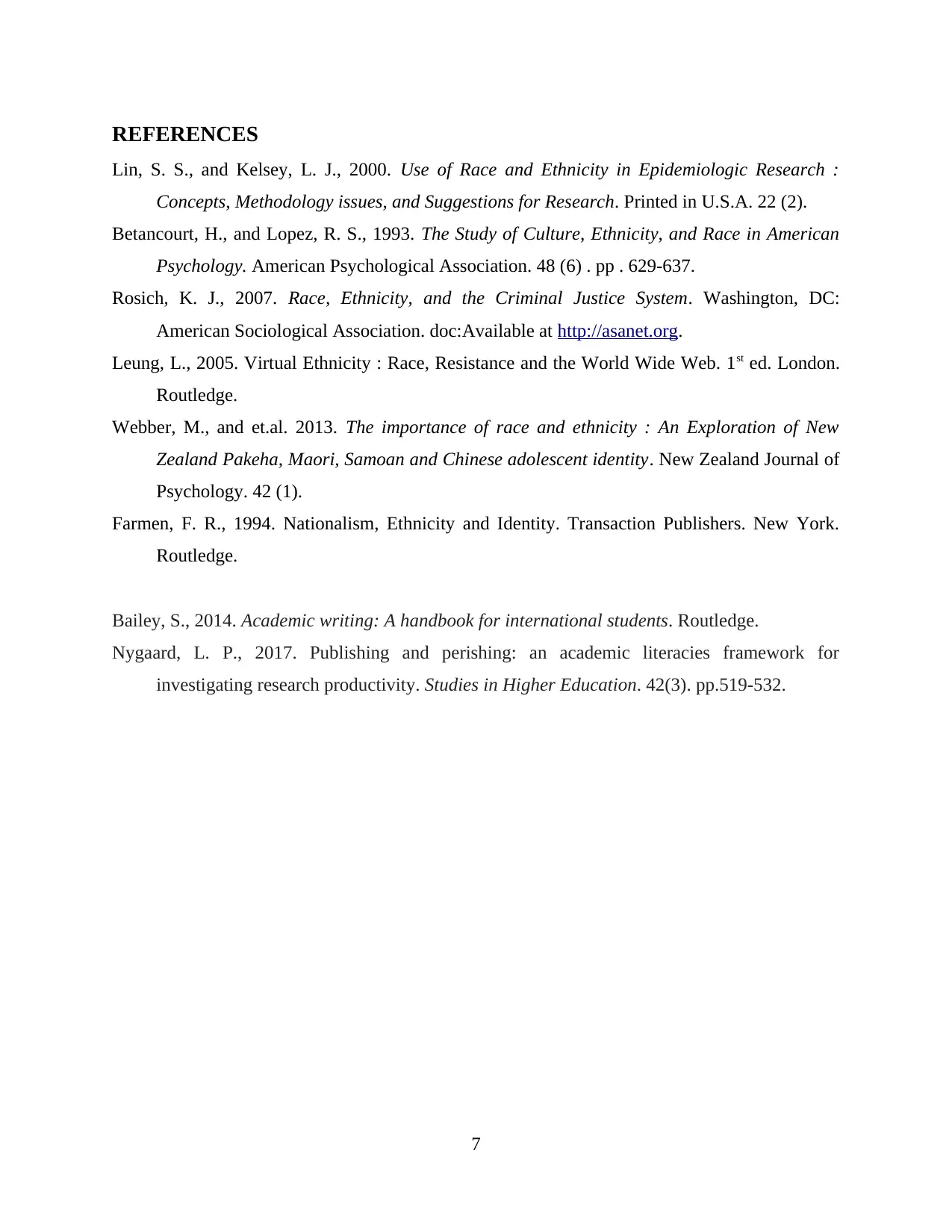
REFERENCES
Lin, S. S., and Kelsey, L. J., 2000. Use of Race and Ethnicity in Epidemiologic Research :
Concepts, Methodology issues, and Suggestions for Research. Printed in U.S.A. 22 (2).
Betancourt, H., and Lopez, R. S., 1993. The Study of Culture, Ethnicity, and Race in American
Psychology. American Psychological Association. 48 (6) . pp . 629-637.
Rosich, K. J., 2007. Race, Ethnicity, and the Criminal Justice System. Washington, DC:
American Sociological Association. doc:Available at http://asanet.org.
Leung, L., 2005. Virtual Ethnicity : Race, Resistance and the World Wide Web. 1st ed. London.
Routledge.
Webber, M., and et.al. 2013. The importance of race and ethnicity : An Exploration of New
Zealand Pakeha, Maori, Samoan and Chinese adolescent identity. New Zealand Journal of
Psychology. 42 (1).
Farmen, F. R., 1994. Nationalism, Ethnicity and Identity. Transaction Publishers. New York.
Routledge.
Bailey, S., 2014. Academic writing: A handbook for international students. Routledge.
Nygaard, L. P., 2017. Publishing and perishing: an academic literacies framework for
investigating research productivity. Studies in Higher Education. 42(3). pp.519-532.
7
Lin, S. S., and Kelsey, L. J., 2000. Use of Race and Ethnicity in Epidemiologic Research :
Concepts, Methodology issues, and Suggestions for Research. Printed in U.S.A. 22 (2).
Betancourt, H., and Lopez, R. S., 1993. The Study of Culture, Ethnicity, and Race in American
Psychology. American Psychological Association. 48 (6) . pp . 629-637.
Rosich, K. J., 2007. Race, Ethnicity, and the Criminal Justice System. Washington, DC:
American Sociological Association. doc:Available at http://asanet.org.
Leung, L., 2005. Virtual Ethnicity : Race, Resistance and the World Wide Web. 1st ed. London.
Routledge.
Webber, M., and et.al. 2013. The importance of race and ethnicity : An Exploration of New
Zealand Pakeha, Maori, Samoan and Chinese adolescent identity. New Zealand Journal of
Psychology. 42 (1).
Farmen, F. R., 1994. Nationalism, Ethnicity and Identity. Transaction Publishers. New York.
Routledge.
Bailey, S., 2014. Academic writing: A handbook for international students. Routledge.
Nygaard, L. P., 2017. Publishing and perishing: an academic literacies framework for
investigating research productivity. Studies in Higher Education. 42(3). pp.519-532.
7
1 out of 10
Related Documents
Your All-in-One AI-Powered Toolkit for Academic Success.
+13062052269
info@desklib.com
Available 24*7 on WhatsApp / Email
![[object Object]](/_next/static/media/star-bottom.7253800d.svg)
Unlock your academic potential
© 2024 | Zucol Services PVT LTD | All rights reserved.





